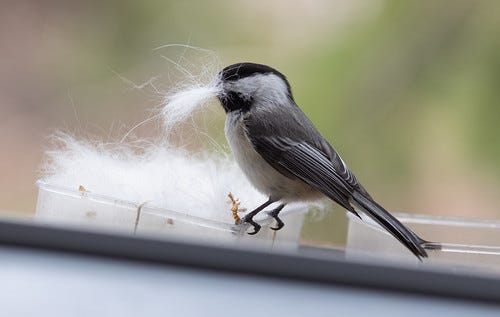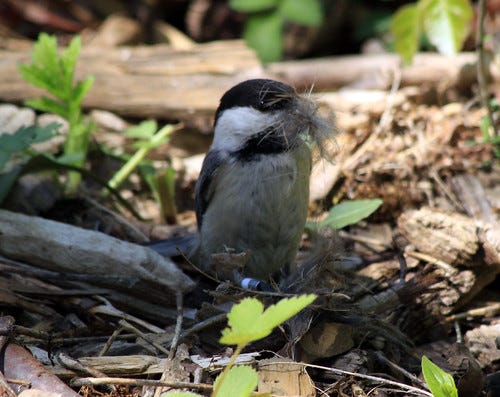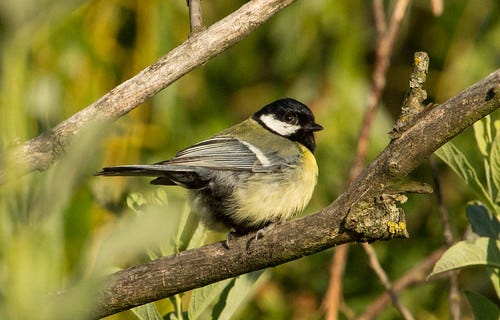Setting out pet fur for birds is dangerous!
A new UK study finds pesticides in fur used in nest linings, reducing nest success.
(Listen to the radio version here.)
Two decades ago, when I wrote 101 Ways to Help Birds, I recommended setting out pet fur as an ideal nesting material. I’ve seen a lot of bird nests with animal fur incorporated into the nest linings, and I’ve watched Chipping Sparrows pluck fur from my golden retriever Bunter and chickadees and titmice taking it from road-killed rabbits and squirrels.
When I wrote the book, most pet fur was still pretty natural. But now, flea and tick preventatives, like the pill I give my dog Pip once a month, lace the fur with pesticides. In the United States, there is virtually no funding for the kind of research that can determine whether the danger to birds using this fur might be offset by the possibility of reducing the number of mites, lice, and flies hurting nestlings, so up until now, I didn’t have a clue whether to amend my recommendation or not. A 2025 study published in the U.K. clarifies the issue.
The researchers examined the fur lining in 103 nests of Eurasian Blue Tits and Great Tits collected in 2020. The species were chosen because, like our own chickadees and titmice, they virtually always line their nests with fur.
The scientists found that in every single nest, the fur was contaminated with at least 2 pesticides—in some, as many as 11—each one in common veterinary use to protect livestock and pets. But are these pesticides actually dangerous for birds? The researchers discovered that the more of these pesticides present in the fur incorporated into a nest, the fewer eggs produced and the higher the chick mortality. So when it comes to setting out fur from treated pets for your local nesting birds, please, just say no.
In the nests examined, 100 percent contained the pesticide fipronil, which is used to control ants, beetles, cockroaches, fleas, ticks, termites, mole crickets, thrips, rootworms, weevils, etc., and is one of the ingredients in Frontline and other popular anti-flea medications for pets. The nest materials for the study were collected in 2020, before the product I now use on my dog Pip (Simparica TRIO) was available. The three pesticides in Simparica (sarolaner, moxidectin, and pyrantel) were not tested for in this study, but based on fact that sarolaner is known to cause tremors, ataxia, and seizures in some dogs, I can’t believe it’s safer than fipronil for baby birds.

Permethrin was another of the most prevalent pesticides found—it was in slightly more than 89 percent of the nests. This pesticide is not just used for pets—it’s in shampoos to treat head lice for humans, and is often sprayed on clothing to protect us from bug bites.
When she was little, our daughter had a rare and dangerous reaction to every single mosquito bite. We didn’t want to put repellants on her skin, so we bought a can of permethrin to spray an over-sized shirt that we could put over her clothes when she played outside. It worked, but Russ and I both hated applying it. We obviously couldn’t spray it in the house, but outdoors didn’t seem much better. We’d wait for a day with no wind and drape the garment over our fence with newspapers beneath to catch as much of the residue as possible so little would fall on our lawn where robins fed and our dog walked, but it still felt dangerous. It wasn't until years later that we discovered pre-treated “Buzz Off” clothing. That treatment is safer, more effective, and much longer-lasting than spraying.
The Insect Shield company also provides that treatment to our own garments. Their process binds permethrin to fibers in a way that spraying cannot, so a single treatment stays effective for the life of the garment or up to 80 washes, reducing the overall amount of permethrin used per garment. Before I went to Peru and Uganda in 2016, I sent the company a few shirts and pants for treatment. I'm still wearing those items, and they’re still protecting me from insect bites. This year, before my trip to Guyana, I had a few more items treated, including socks and lightweight sun-protection gloves. Everyone else in our group got chigger bites—in some cases, a lot of chigger bites—when we visited the Georgetown Botanical Gardens. I didn’t get a single chigger bite. Indeed, I ended up with just one bite on the entire trip, on my wrist near my watchband on the side my gloves didn’t quite reach.
I tend to keep clothing for a long time—I still have, and wear, items I bought back in the 1970s and 80s. Now that we know that permethrin really is harming birds, when I do discard old clothing that was treated, I’ll be very careful to wrap it tightly in plastic before putting it in the garbage that will end up in the landfill. Wads of pet fur from brushing or trimming a dog with any kind of flea-and-tick protection should be disposed of in the same way. Don't set it out for nesting birds, and don’t compost it.
Environmental issues are growing ever more complex even as climate change is making insect-borne diseases ever more prevalent. Yet profit-focused corporate entities and anti-regulation billionaires keep pressuring government to cut back on pesticide research and regulations even as our Secretary of Health and Human Services closes his eyes to the evisceration of the EPA to focus his attention on limiting our access to life-saving vaccines. I sure wish I could tell him to buzz off.









wow- this totally opened my eyes. for the past few years i've saved fur from our little dog to put out for nesting birds. this year i was late so it's still in a jar and now will go into the garbage. this is so sad and i hope many people read this. thank you, laura, for all your work for birds and our world. and the picture of you and pip is so cute!!!!